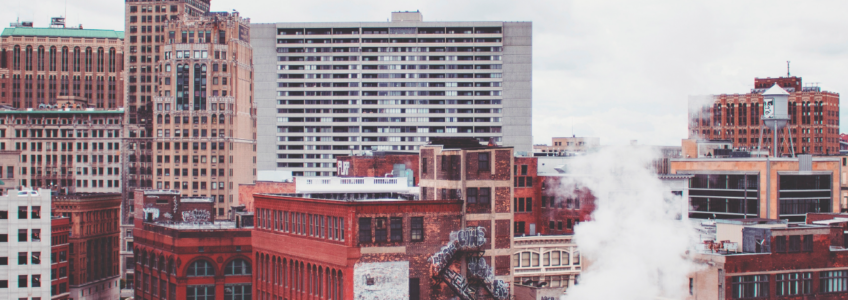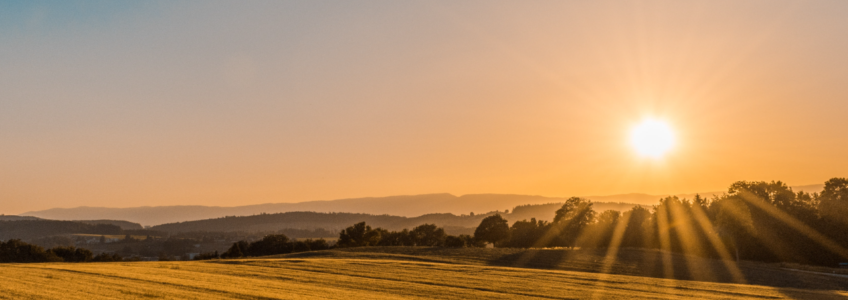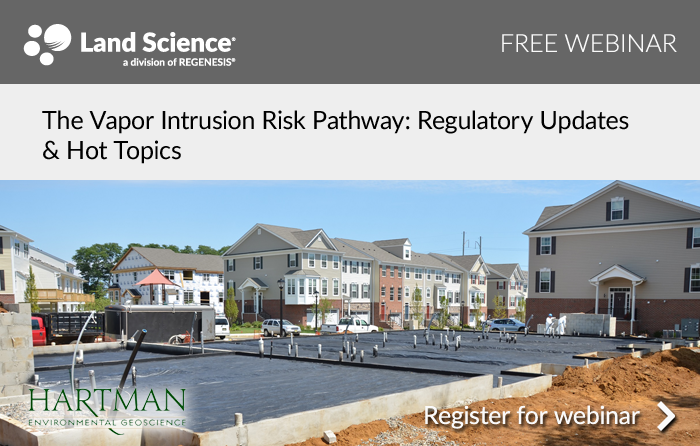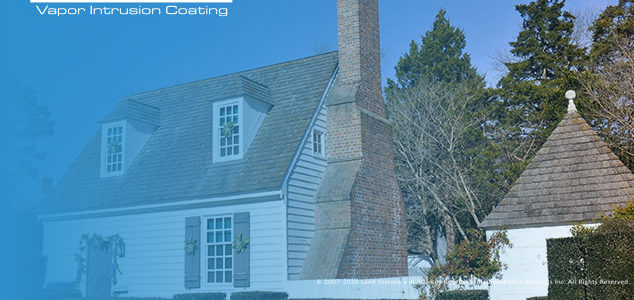What is Vapor Mitigation?
Vapor mitigation is a segment of the environmental industry that is maturing rapidly. There are many new technologies emerging to prevent vapor intrusion which safely and effectively address a variety of structures. Vapor mitigation methods are classified as either passive or active.
Passive vapor mitigation involves barriers installed in existing buildings or pre-construction to prevent the entry of chemical vapors. Passive vapor barriers are installed in a variety of structures including homes, businesses, or other industrial buildings and are generally a cost-effective approach, making passive vapor barriers the most common and appealing method for vapor mitigation. One approach available for existing structures is to seal or fill the cracks in a building’s floor slab or around pipes and utility lines in walls. Retro-Coat™ is an example of a vapor barrier coating system that protects existing structures and can be customizable to fit the unique needs of the structure. Another method of passive mitigation is installing a venting layer in a basement which pushes harmful vapors toward the sides of the building and then outdoors. A third vapor barrier option involves installing a barrier made up of strong plastic-like sheets placed beneath a building’s foundation or in crawl spaces. At Land Science, Geo-Seal® is a safe and proven vapor barrier system comprised of three intensive layers designed and installed in newly constructed buildings. Scientifically tested to provide the highest level of protection from vapor intrusion, Geo-Seal is the trusted source for many environmental professionals and developers across the US and Canada.
Active mitigation is the practice of changing the pressure between the sub-slab and the inside of the building to keep chemical vapors out. This method is considered to be highly effective but is usually more expensive than a passive system due to the high cost of maintenance. A sub-slab depressurization (SSD) system involves the use of a blower or electric fan. A suction pit is installed in the sub-slab allowing for contaminated groundwater vapors to rise to the surface and into the structure. The electric fan or blower draws out the chemical vapors and releases them outside the building’s structure. This system is highly effective and is used for radon and VOC control. Another active mitigation system available involves building pressurization which adjusts a building’s heating, air-conditioning, and ventilation system indoors relative to the pressure in the sub-slab. When positive pressure is introduced inside the building, it prevents chemical vapor from entering the building. This method tends to produce a high energy cost and is considered to be less-effective compared to SSD.
Additionally, there are solutions developed using both passive and active methods. For example, a passive system can be designed to become active if needed and is offered as one of the options available through Land Science. Vapor Vent™ goes above and beyond by providing cost savings, speedy installation, and other performance benefits.
Sources:
–http://www.newmoa.org/cleanup/cwm/vapor/FolkesPresentationApril2006.pdf
–https://nepis.epa.gov/Exe/ZyNET.exe/P100F9XC.TXT
–https://www.trcsolutions.com/writable/images/TRC-white-paper-Vapor-Intrusion-FINAL-March-2016.pdf
USC Village Project Incorporates Geo-Seal & Vapor Vent as Part of $700 million Student Residential Construction
Project Highlights
- USC was able to stay on-time and on-budget while eliminating any future exposure to vapor intrusion.
- A Geo-Seal barrier system was installed to prevent potential vapor exposure as part of the $700 million University of Southern California (USC) student residential village project.
- Geo-Seal vapor barrier provides the new student residential colleges with the highest level of protection against vapor intrusion
Project Summary
As a part of the ongoing growth of the University of Southern California (USC) and in order to continue to attract top student talent, the University elected to invest $700 million in a new Residential Village. This village houses residential colleges, retail spaces, recreational facilities, and learning spaces. The USC trustees, alumni, parents, and friends envisioned the Residential Village to be a living and learning environment unlike any other, incorporating the latest technology with an inspiring aesthetic.
In every step of this expansion, the concern for student’s health and safety was the leading priority. This concern for safety, paired with a vision of a world-class living and learning environment, inspired the developers to incorporate preventative measures including Geo-Seal into their design and construction plans.
Download the complete case study
© 2021 All rights reserved. Geo-Seal is a registered trademark of Epro Services Inc.
Brownfield Developments
Brownfields are a big concern in the U.S. due to the environmental, economic, and political issues they represent. A Brownfield site is a property whose sale or reuse is prevented due to the presence of contaminants or pollutants. While these properties often pose liabilities for the communities they are a part of, they also represent business opportunities for environmental consulting firms and can be a springboard for community redevelopment and economic revitalization because of the EPA’s Brownfields Program.
The US EPA is behind many of the developments concerning Brownfield sites. This US EPA provides grants and technical assistance to communities to assess, safely clean up, and sustainably reuse contaminated properties. The grants make way for ensuring clean air, water, and land preservation and restoration.
A study done in 2015 proves the economic value of cleaning Brownfield properties outlining the benefits to communities and citing positive outcomes like residential property value increasing by up to 15% within 1.5 miles from the affected site. Every year the US EPA assesses its accomplishments among the nation’s communities. The most recent and comprehensive results as of May 1st, 2017 include: 26,722 properties assessed nationwide, 124,760 jobs leveraged from the results, $23.950 BN dollars leveraged, and 67,419 acres anticipated to be ready for use again. These numbers are promising in the developments at Brownfield sites. In Pennsylvania for example, the state received $1.8 million in funding to examine Brownfields. This enacted local organizations to take on many new projects while making significant progress in impacting contaminated sites.
While the benefits of the EPA Brownfields program are clear, challenges remain for property developers and environmental professionals who are tasked with cleaning up and remediating these sites before they are cleared by regulators for re-use. Perhaps most notably, vapor intrusion from soil and groundwater contaminants is often a problem that must be mitigated. As risk standards and other compliance issues associated with contaminant vapor intrusion continually evolve, engineered controls like those offered by Land Science provide a practical, cost-effective solution to eliminate risks.
Recent advances in contaminant vapor intrusion mitigation developed by Land Science have assisted developers, engineering firms, regulators, and land owners by providing technically sound solutions effectively mitigating these issues. These solutions include Geo-Seal Vapor Intrusion Barrier for new building construction, and Retro-Coat Vapor Intrusion Coating for existing structures.
Land Science is a vital part of Brownfield developments in the environmental industry. Land Science contracts with environmental consultants and developers to remediate contaminated Brownfield sites using effective technology and product solutions. There is a lot of value in cleaning up Brownfields that positively affects not only the environment but our economy and communities. Land Science takes pride in Brownfield development efforts nationwide. Most notably, in 2016 Land Science won the Phoenix Award for an impressive brownfield revitalization project. The project was a severely contaminated site that was remediated and redeveloped into the Cardinal Health Center in Michigan. Additionally, Land Science attends Brownfield conferences annually which focus on environmental rejuvenation to stimulate economic activity in contaminated areas.
Sources:
https://www.epa.gov/brownfields
http://news.nationalgeographic.com/2017/03/environmental-protection-agency-budget-cuts/
What is Vapor Intrusion?
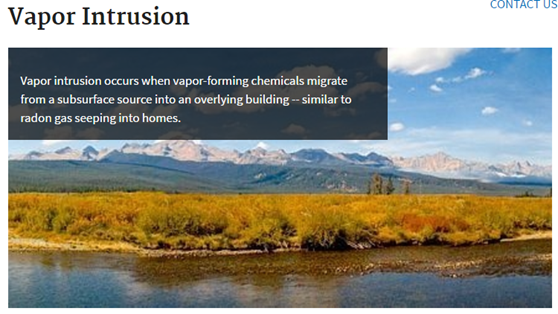
Vapor intrusion (VI) is a relatively new concept in the environmental industry first recognized in the 1980’s. It was discovered that contaminants in the soil and groundwater could be the cause behind poor indoor air quality through the movement of vapors coming up through the ground or slab.
Vapor Intrusion is defined as a process by which chemicals in the soil or groundwater migrate to indoor air above a contaminated site. These chemicals are often known as Volatile Organic Compounds or VOCs. Vapors typically enter a living space through pathways underground in a building’s foundation. These active vapors can pass through cracks in the wall, gaps from utility lines, or even through concrete which is naturally porous.
In extreme cases, the vapors may put humans at risk. If inhaled, those affected could encounter minor health concerns and even long-term effects. The issue of safety is always a concern, since in addition to inhalation of VOCs, these vapors can also become flammable. The degree of the vapors’ impact on human health involves factors that include its chemical concentration, ventilation, and the building’s occupancy.
The US Environmental Protection Agency (US EPA) has put in place measures to manage and eliminate vapor intrusion risks. The Comprehensive Environmental Response, Compensation, and Liability Act (CERCLA) was implemented nationwide and provides a Federal “Superfund” to clean up abandoned sites with pollutants and contaminants. If not administered by a private party, the EPA takes control and mitigates vapor intrusion.
To regulate VI, the EPA has set standards for acceptable indoor air quality levels. Upon determining exposure and risk, there are a variety of mitigation methods to lessen the vapor effects and disturbances. At Land Science, we responded to a need in the industry with an effective and proven solution: an easily installable, effective barrier system to protect against chemicals like PCE, TCE, and Benzene.
Vapor intrusion mitigation may be a newer advancement in environmental technology today, but the Land Science team is staffed with experts from the environmental industry trained and knowledgeable in understanding and providing the highest level of protection to help improve air quality in new and existing structures. As leaders in the field, we are proud to provide the most innovative, groundbreaking, and cost-effective vapor intrusion barrier systems to reduce risk and liability while protecting your clients and their properties from VI exposure. Search our website to find out more.
The Vapor Intrusion Risk Pathway: Regulatory Updates & Hot Topics
Speakers: Blayne Hartman, PhD President, Hartman Environmental Geoscience and Hieu Nguyen Senior Research Engineer, Land Science
Land Science® is pleased to present a webinar with Dr. Blayne Hartman of Hartman Environmental Geoscience, a nationally recognized vapor intrusion expert, having assisted various governmental agencies with numerous regulatory vapor intrusion guidances and memorandums over the past decade as vapor intrusion has continued to be at the forefront of evolving regulations. During this webinar presentation, Dr. Hartman discusses the latest in regulatory changes across the nation along with practical assessment strategies for navigating the vapor intrusion pathway.
Joining Dr. Hartman is Hieu Nguyen, Senior Research Engineer at Land Science. With Hieu’s years of experience within the vapor mitigation and vapor barrier world, he has extensive knowledge and understanding of key aspects relating to appropriate site specific mitigation systems, as well as testing and evaluations of these systems. Hieu discusses unique methods to retro-fit and mitigate vapor intrusion for existing structures, along with the evaluation of vapor barrier physical properties. He will also cover Land Science’s barrier testing and provide detail on understanding diffusion coefficient testing for vapor barrier systems.
Webinar Recording Now Available
Complete the form below to view the webinar recording.
Client Spotlight: Yen-Vy Van, Senior Hydrogeologist at Maul Foster & Alongi
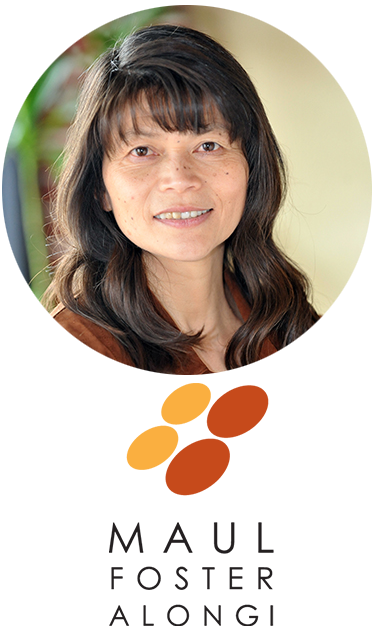 When you ask Yen-Vy Van, Senior Hydrogeologist at Maul Foster & Alongi, Inc. (MFA), about her day-to-day responsibilities, it’s hard to believe that one person could do so much. That’s because her role at Maul Foster & Alongi, Inc., a leading environmental engineering and planning firm in the Pacific Northwest and valued REGENESIS® client, stretches beyond just investigating and remediating impacted sites. From preparing technical documents and reports, to project and client management, to proposal development and other key duties, Van’s involvement seems to touch on nearly every aspect of what MFA does for their clients. Shares Van, “I also manage aspects of client marketing, mentor junior staff members, and conduct field work.” With so many responsibilities, choosing what she enjoys most can be difficult, but a few come readily to mind. Continues Van, “I especially enjoy the technical aspects of my work, such as applying forensic analysis and groundwater modeling of contaminants during remedial investigations to complete a more thorough investigation and understanding of the transport and fate of contaminants impacting the subsurface. I also enjoy the collaborative work we do at MFA – working with and learning from other professionals such as planners, civil engineers, and remediation engineers amongst other specialized professionals.”
When you ask Yen-Vy Van, Senior Hydrogeologist at Maul Foster & Alongi, Inc. (MFA), about her day-to-day responsibilities, it’s hard to believe that one person could do so much. That’s because her role at Maul Foster & Alongi, Inc., a leading environmental engineering and planning firm in the Pacific Northwest and valued REGENESIS® client, stretches beyond just investigating and remediating impacted sites. From preparing technical documents and reports, to project and client management, to proposal development and other key duties, Van’s involvement seems to touch on nearly every aspect of what MFA does for their clients. Shares Van, “I also manage aspects of client marketing, mentor junior staff members, and conduct field work.” With so many responsibilities, choosing what she enjoys most can be difficult, but a few come readily to mind. Continues Van, “I especially enjoy the technical aspects of my work, such as applying forensic analysis and groundwater modeling of contaminants during remedial investigations to complete a more thorough investigation and understanding of the transport and fate of contaminants impacting the subsurface. I also enjoy the collaborative work we do at MFA – working with and learning from other professionals such as planners, civil engineers, and remediation engineers amongst other specialized professionals.”
Choosing Environmental Remediation
Choosing a career in environmental remediation came somewhat naturally to Van, since her interest in groundwater resources began early on with her university studies. “Environmental engineering was a natural segue for me. As a geologist/hydrogeologist, my interests revolved around groundwater resources. The area of environmental remediation of the subsurface is complex and fascinating, and provides the opportunity to rigorously evaluate and investigate the subsurface regime including soils, groundwater, free product, and vapor. Plus, I love scientific investigations, research, technologies, and engineering.”
Van’s university studies include a B.S. from California State University of Long Beach, and a M.S. from California State University of Los Angeles. To stay abreast of the rapid changes in her industry, she enjoys the opportunities to continue technical education in the environmental investigation and remediation fields. These include governmental organizations ranging from the EPA’s CLU-IN and USGS, to professional organizations and remediation experts that include REGENESIS, and others which offer webinars and courses/trainings throughout the year. She goes on to say, “I try to fit them in as often as possible. I believe in staying engaged to continually improve my technical understanding and capabilities.” Living just south of Tacoma, WA, Van works out of MFA’s Seattle office, and travels on an as-needed basis. She also works with the company’s Bellingham, Vancouver, and Portland offices on occasion.
Working with REGENESIS to Ensure Client Success
When asked what she enjoys most about working with REGENESIS, Van points to the high level of technical knowledge she sees from the REGENESIS staff. Says Van, “The REGENESIS technical team is terrific for many reasons. This includes their expertise, versatility, and proven successes. REGENESIS’ technical sales managers understand not only the technical aspects of environmental remediation, but that the various applications have consequential effects on businesses. I also like that REGENESIS factors in the property usage during their remediation design.” In addition, Van appreciates their multifaceted approach. She continues, “The versatility and remedial solutions REGENESIS offers makes them a recognized expert. Also, their tiered approach to targeting the biological and chemical reactions of contaminants and requirements for microbes to aggressively breakdown contaminants has proven to be quite successful.” When it comes to specific REGENESIS products, Van points to a couple in particular. “We’ve had the most success with ORC Advanced® and 3-D Microemulsion®. We’ve been able to obtain the much coveted No Further Action determination from the Washington Department of Ecology for sites where we have applied these amendments. Clients appreciate the minimized disruptions to their properties’ usages. With respect to vapor intrusion issues, we’ve had successes with the installation of Land Science®’s Retro-Coat Vapor Intrusion Barrier System. The mitigation and improvements in indoor air quality that results after the installation of these sealants have enabled our clients to proceed with property transactions. Without these successful mitigation measures, our clients would not have been able to proceed with future transactions on these properties.”
Married for 23 years, Van and her husband have two daughters. “One is a junior at Washington State University and the other is a sophomore in high school. They keep us sane and comically insane at times!” In her free time, she enjoys playing racquetball and competing in regional and local tournaments, and she and the family enjoy backpacking and whitewater rafting. Gardening while listening to baseball games on the radio is another hobby. In her spare time she volunteers at the county’s local library and hopes to get involved in Habitat for Humanity and working with a children organization in the future.
Asked how she would encourage others to join the field of environmental sciences, she concludes by relating how much she enjoyed presenting to her daughter’s elementary and junior high schools. “I’ve presented an hour-long compressed introduction to geology, environmental science, environmental engineering and how these fields apply to our daily lives as well as the exciting projects we engage in” says Van. “The students are usually interested, engaged, and curious. I believe engaging students at these levels is a good start to have them consider the sciences, the environment, engineering, and technologies as potential fields to explore for personal and professional interests.”
REGENESIS is proud to have Yen-Vy Van, Senior Hydrogeologist at Maul Foster & Alongi, Inc., as a valued client, and appreciates her expertise in hydrogeology and environmental engineering, and its impact in providing successful remediation outcomes for REGENESIS and its clients.
Retro-Coat™ Applied to Former Jazz Club Ensures Protection from Vapor Intrusion
At a former popular Jazz club in the historic section of downtown Renton, Washington, indoor air quality was impacted with volatile organic compounds associated with dry cleaning solvents that had spread from a nearby dry cleaning operation. Working with Land Science, the environmental consulting firm, Maul Foster & Alongi used Retro-Coat to successfully mitigate vapor intrusion in the building, and the owner is now pleased that the sale of his property can commence.
VOC Contaminants Reduced in one month for homeowners in Virginia Following Retro-Coat Installation
At a residential site in Virginia, vapor intrusion affected the interior living space of a private building due to release of heating oil from an Above Ground Storage Tank (AST) to the sub slab environment beneath the structure. Indoor air quality sampling after the release revealed several petroleum compound contaminants at concentrations above EPA Residential Screening Levels.
VOC Contaminants Reduced in one month for homeowners in Virginia Following Retro-Coat Installation
Project Highlights
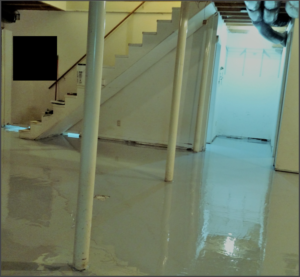
- VOCs reduced within one month of operation
- Achieved site goals of meeting VDEQ and DEH IAQ standards, rendering home safe for habitation
Project Summary
At a residential site in Virginia, vapor intrusion affected the interior living space of a private building due to release of heating oil from an Above Ground Storage Tank (AST) to the sub-slab environment beneath the structure. Indoor air quality sampling after the release revealed several petroleum compound contaminants at concentrations above EPA Residential Screening Levels. To minimize the displacement of the homeowners for an extended period of time, the vapor intrusion mitigation system had to produce good indoor air quality results as quickly as possible.
Leading environmental firm, Duncklee & Dunham, designed and installed an active, sub-slab vapor mitigation system and sealed the surface of the slab in the interior of the building with 1000 sq. ft. of Retro-Coat™ applied. The active system consisted of vertical vent wells installed in the building slab to a depth just below the bottom of the slab and connected to a manifold. Soil vapors were extracted from the sub-slab environment with an electric radon fan and exhausted to the exterior atmosphere. Retro-Coat primer and sealant were then applied to the entire surface area of the interior building slab to provide supplemental vapor intrusion prevention.
Technology
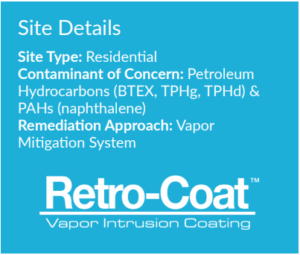
The Retro-Coat Vapor Intrusion Coating System is a complete product line that consists of chemically resistant materials to properly protect existing structures from the threat of contaminant vapor intrusion.
Results
The vapor mitigation system reduced VOCs in the exhaust gas within one month of operation, and reduced levels of petroleum compounds in indoor air to the extent that the building was suitable for occupancy six weeks after the system startup.
About the Consultant
Duncklee & Dunham is an environmental consulting firm based in North Carolina specializing in environmental geology, hydrogeology, site investigation and remediation, industrial hygiene, civil engineering and brownfields. For questions regarding this project, please contact Andrew Rodak, P.E. at (919) 858-9898.
© 2021 All rights reserved. Geo-Seal is a registered trademark of Epro Services Inc.
Client Spotlight: Bruce Savage, Vice President, Director of Environmental Services at Geotechnical Consultants
 For Bruce Savage, Vice President, Director of Environmental Services at Geotechnical Consultants, Inc. (GCI), a leading full-service, geotechnical engineering and environmental consulting firm, motivation comes easy in fulfilling his day-to-day responsibilities. At GCI, a valued Land Science® client, Bruce enjoys the satisfaction of working with clients to determine where concerns exist, and then develops and implements workable, cost-effective remedies that satisfy all parties. He achieves optimum results by working closely with real estate developers, property owners, their business partners and regulatory personnel to identify environmental contamination and the appropriate steps to remedy contamination. Shares Savage, “The goal is always to identify workable pathways to development using remedies that protect human health and the environment, meet regulatory requirements, and ensure future compliance and protectiveness.”
For Bruce Savage, Vice President, Director of Environmental Services at Geotechnical Consultants, Inc. (GCI), a leading full-service, geotechnical engineering and environmental consulting firm, motivation comes easy in fulfilling his day-to-day responsibilities. At GCI, a valued Land Science® client, Bruce enjoys the satisfaction of working with clients to determine where concerns exist, and then develops and implements workable, cost-effective remedies that satisfy all parties. He achieves optimum results by working closely with real estate developers, property owners, their business partners and regulatory personnel to identify environmental contamination and the appropriate steps to remedy contamination. Shares Savage, “The goal is always to identify workable pathways to development using remedies that protect human health and the environment, meet regulatory requirements, and ensure future compliance and protectiveness.”
The path to a career in remediation
Savage’s path to his current position as Vice President, Director of Environmental Services began with his Bachelor of Science in Geology and Mineralogy from The Ohio State University. He followed that up with his Master’s in Geological and Earth Sciences/Geosciences from the University of Cincinnati. His academic achievements led to work experience as a field technician and a driller’s helper with GCI, nearly 30 years ago, then as an environmental geologist, prior to being promoted to Vice President. In addition, Savage received the Certified Professional designation from the Ohio EPA in 2003. When asked about how he initially chose a career in environmental remediation, he admits that in some ways, his career chose him. Continues Savage, “The truth is, this career found me. I was fortunate enough to have the right training at the right time, and be in the right place. Central Ohio has seen an amazing amount of urban revitalization in recent years, and GCI has experienced much of that work.” When asked what he enjoys most about his work, he points to the sense of being a difference-maker within his community and surrounding area. “The best part of my job,” he says, “Is working on and seeing new development projects and historic preservation happening all around Columbus.” And the biggest challenge? “Keeping up with project schedules!”
Residing in German Village, a historic district in Columbus, and a short drive to the GCI offices in Westerville, Ohio (just outside Columbus), Savage enjoys a close association with Land Science® employees, and is a strong advocate of its products as well. “Land Science® has consistently provided timely, effective remediation product solutions,” continues Savage. “For the most part, we use Geo-Seal® and Vapor Vent™, due to the fact that most of our sites are urban redevelopment projects where Vapor Intrusion (VI) is a concern. We recommended installation of a VI mitigation system at a former manufacturing site being redeveloped for apartments, and the owner selected the Geo-Seal® and Vapor Vent™ system. The remedy installation aided in the project receiving a Covenant Not to Sue from the Ohio EPA following our submittal of a No Further Action Letter,” Shares Savage. He continues, “In another instance, we recommended a floor sealing system for VI, and the owner selected the Retro-Coat™ system. At that site, indoor air contaminant concentrations were either eliminated or significantly reduced.”
Keeping pace with the vapor intrusion industry
To keep pace with the ever changing environmental remediation industry, particularly with regard to vapor intrusion, Savage regularly attends Ohio EPA-sponsored courses, and participates in webinars. Says Savage, “Ohio requires its VAP Certified Professionals to receive at least 12 hours of approved continuing education annually.” When it comes to identifying trends within the industry, he points to what he sees as a continued movement toward urban revitalization. “This will require creative solutions for soil, groundwater and vapor intrusion mitigation,” he says. “The vapor intrusion to indoor air pathways is receiving significant attention from the business and regulatory communities, and VI mitigation installations are becoming more and more common.” And as for what the future may hold for Geotechnical Consultants, Inc., he goes on to say it’s about service and solutions. “GCI’s philosophy has always been: provide our clients with great service and practical solutions for a reasonable fee, and in addition, provide our staff with personal and professional growth opportunities.”
Married for 35 years, Savage and his wife have three children and two grandchildren who “we enjoy spoiling.” When he has time away from his busy work schedule he enjoys learning about history and studying viniculture. He also manages to find time to serve as a Stephen Minister through his church, while supporting Gracehaven, The James Cancer Hospital, and other charities.
Change is inevitable
Since he works in such a fast-paced, industry, Savage realizes that change is inevitable, and says that over the past few decades he’s noticed a much higher degree of professionalism in environmental remediation. He concludes, “Since the 1980s the environmental consulting industry has gone from what I would call a sort of “garage-band” field, to a much more sophisticated group of professionals working on solutions to complex human health and regulatory issues.”
Land Science® is proud to have Bruce Savage, Vice President and Director of Environmental Services at Geotechnical Consultants Inc., as a valued client and partner in environmental remediation, and appreciates his vast knowledge and experience in providing successful remediation outcomes for Land Science® and its clients.


